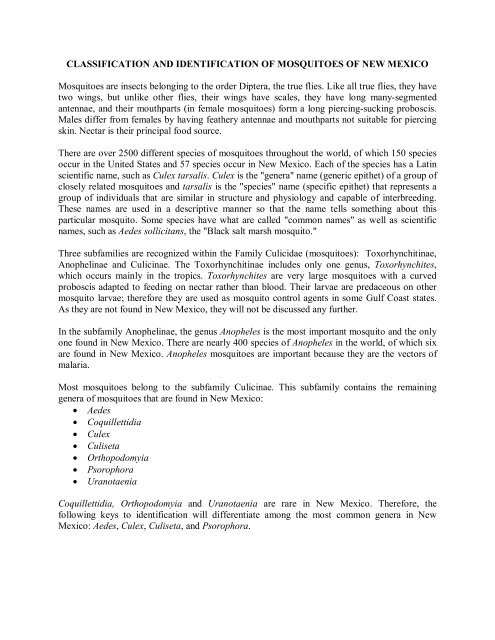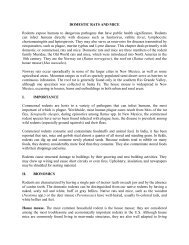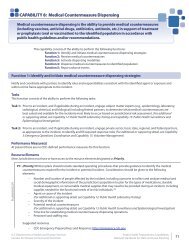Mosquito identification - New Mexico Department of Health
Mosquito identification - New Mexico Department of Health
Mosquito identification - New Mexico Department of Health
You also want an ePaper? Increase the reach of your titles
YUMPU automatically turns print PDFs into web optimized ePapers that Google loves.
CLASSIFICATION AND IDENTIFICATION OF MOSQUITOES OF NEW MEXICO<strong>Mosquito</strong>es are insects belonging to the order Diptera, the true flies. Like all true flies, they havetwo wings, but unlike other flies, their wings have scales, they have long manysegmentedantennae, and their mouthparts (in female mosquitoes) form a long piercingsucking proboscis.Males differ from females by having feathery antennae and mouthparts not suitable for piercingskin. Nectar is their principal food source.There are over 2500 different species <strong>of</strong> mosquitoes throughout the world, <strong>of</strong> which 150 speciesoccur in the United States and 57 species occur in <strong>New</strong> <strong>Mexico</strong>. Each <strong>of</strong> the species has a Latinscientific name, such as Culex tarsalis. Culex is the "genera" name (generic epithet) <strong>of</strong> a group <strong>of</strong>closely related mosquitoes and tarsalis is the "species" name (specific epithet) that represents agroup <strong>of</strong> individuals that are similar in structure and physiology and capable <strong>of</strong> interbreeding.These names are used in a descriptive manner so that the name tells something about thisparticular mosquito. Some species have what are called "common names" as well as scientificnames, such as Aedes sollicitans, the "Black salt marsh mosquito."Three subfamilies are recognized within the Family Culicidae (mosquitoes): Toxorhynchitinae,Anophelinae and Culicinae. The Toxorhynchitinae includes only one genus, Toxorhynchites,which occurs mainly in the tropics. Toxorhynchites are very large mosquitoes with a curvedproboscis adapted to feeding on nectar rather than blood. Their larvae are predaceous on othermosquito larvae; therefore they are used as mosquito control agents in some Gulf Coast states.As they are not found in <strong>New</strong> <strong>Mexico</strong>, they will not be discussed any further.In the subfamily Anophelinae, the genus Anopheles is the most important mosquito and the onlyone found in <strong>New</strong> <strong>Mexico</strong>. There are nearly 400 species <strong>of</strong> Anopheles in the world, <strong>of</strong> which sixare found in <strong>New</strong> <strong>Mexico</strong>. Anopheles mosquitoes are important because they are the vectors <strong>of</strong>malaria.Most mosquitoes belong to the subfamily Culicinae. This subfamily contains the remaininggenera <strong>of</strong> mosquitoes that are found in <strong>New</strong> <strong>Mexico</strong>:· Aedes· Coquillettidia· Culex· Culiseta· Orthopodomyia· Psorophora· UranotaeniaCoquillettidia, Orthopodomyia and Uranotaenia are rare in <strong>New</strong> <strong>Mexico</strong>. Therefore, thefollowing keys to <strong>identification</strong> will differentiate among the most common genera in <strong>New</strong><strong>Mexico</strong>: Aedes, Culex, Culiseta, and Psorophora.
MOSQUITO IDENTIFICATION<strong>Mosquito</strong>es undergo a complete metamorphosis during their life cycle: egglarvapupaadult.The larval and adult stages are most frequently used in <strong>identification</strong>. However, the eggs can alsobe differentiated.Typical anopheline eggs are shown in Figs. 1 and 2. These are laid singly on the water surface.abFig. 1. Single eggs <strong>of</strong> Anopheles:a) dorsal view, b) side viewFig. 2. Cluster <strong>of</strong> Anopheles eggs floating onthe surface <strong>of</strong> the water in typical stellate andgeometric patterns.Culex and Culiseta also oviposit on the water, but glue their eggs into a raft (Fig. 3). Eggs <strong>of</strong>Psorophora, and Aedes are laid singly above the water line or in depressions subject to flooding(Fig. 4).Fig. 3. Collection <strong>of</strong> eggs <strong>of</strong> Culexforming a composite floating raft <strong>of</strong>many eggs, with its head enddownwards. The whole eggraft istypically convex below and concaveabove with upturned ends.Fig. 4. Single egg <strong>of</strong> an Aedesmosquito.
Anopheline and culicine larvae can be distinguished in the field by their different restingpositions in the water as shown in Fig. 5.Fig. 5. Anopheles larva on left,culicine larva on right. Note absence<strong>of</strong> siphon (air tube) in Anopheles andposition parallel to water surface.Culicine larvae have siphons throughwhich they obtain air from thesurface, enabling it to feed below thesurface.KEY TO COMMON GENERA OF MOSQUITO LARVAE IN NEW MEXICOSiphon (air tube) present,no palmate hairsUnknown <strong>Mosquito</strong> LarvaSiphon absent, palmate hairs onabdominal segmentsCulicinae (Fig. 6), keycontinues on next pageAnopheles (Fig. 7)Palmate hairsFig. 6Fig. 7No siphon
Basal tuft present on siphon– Culiseta, Fig. 8No basal tuft on siphonBasal tuft on siphonFig. 8. Culiseta larva3 or more pairs <strong>of</strong>siphonal tufts –Culex, Fig. 9Only one pair <strong>of</strong>siphonal tufts –go to next pageSiphonal tuftsFig. 9. Culex larva
Saddle completely encircles anal segmentAND pierced by ventral brush –Psorophora, Fig. 10Saddle usually not encircling anal segment(Figs. 11 & 12), but if so, tufts <strong>of</strong> ventralbrush confined posterior to the saddle (Fig.13) – AedesVentral brushSaddleFig. 10. Psorophora larvaFig. 11. Incomplete saddle(Aedes vexans)Fig. 12. Incomplete saddle(Aedes dorsalis)Fig. 13. Complete saddle, and ventralbrush confined to posterior <strong>of</strong> saddle(Aedes trivittatus)
IDENTIFICATION OF ADULT MOSQUITOESAdult mosquitoes are distinguished from other flies by having scales on the wing veins, wingmargins and most <strong>of</strong> the body; and a long proboscis.Resting Stance:AnophelesCulicineMale mosquitoes have plumose (bushy) antennae and the palpi are as long as the proboscis andclubbed at the end.Male AnophelesMale CulicineFemale mosquitoes have antennae with fewer, shorter hairs. In female Anopheles, the palpi areas long and straight as the proboscis, while palpi <strong>of</strong> female Culicine are considerably shorter.Female AnophelesFemale Culicine
Among the Culicine mosquitoes, Culex and Culiseta have blunt abdomens (Fig. 14), whileAedes, and Psorophora have pointed abdomens (Fig. 15).Fig. 14 Blunt abdomen <strong>of</strong> Culex and CulisetaFig. 15 Pointed abdomen <strong>of</strong> Aedes andPsorophora
















